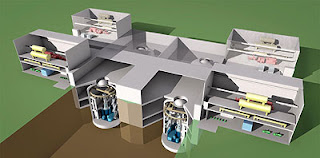Lynchburg, Virginia Has Reasons To Be Excited About Nuclear Industry Growth Prospects

Last weekend, I received a press release from Babcock and Wilcox describing their recent leasing of a 50,000 square foot building in Lynchburg capable of eventually hosting a team of 300 engineers, reactor designers, and support people. The entire facility will be focused on efforts to complete the mPowerTM modular reactor design work and then to complete the process of getting the system through the NRC licensing process. Initially, thirty-five people will move into the building and set it up for an ever expanding team.
(Image description: Two B&W mPower™ nuclear reactors configured as a 250 megawatt nuclear power plant.)
The Lynchburg News & Advance has taken notice of the excitement and expansion at one of its primary local employers with an editorial titled Potential for Jobs at B&W Boosts Area. That is welcome news in a town that has been through a rough patch that started well before the rest of the country entered into a recession. I am passingly familiar with the area – my college roommate lives there and I have had the opportunity to visit on a number of occasions. I have also had a lot of chats with my buddy over the years; he is a well respected systems engineer with project management experience, mainly in electronics and cellular communications.
I remember a time when his best opportunity for remaining in Lynchburg and keeping the little horse ranch that he and his wife have built into a very pleasant place to live was to find a way to get a recall to active duty for a year in Washington, DC, within weekend commuting distance of Lynchburg. During that period, I was also a geographic bachelor living in Annapolis; it gave us an opportunity to renew our friendship but it was not an easy time. He even invited me to a gathering at his home where he hosted a number of fellow engineers from Ericsson who were interested in mutual support and finding new employment opportunities. Fortunately those challenging times are quite a ways in the past for my friend, but not necessarily for the area.
With that background knowledge, however, it does not surprise me to read editorial passages like the one below in the Lynchburg press:
The expansion also means that B&W remains committed to producing the first nuclear reactor in the United States since the 1970s. The firm is competing with Areva, whose North American headquarters are located here, General Electric and Westinghouse, among others, for that distinction.
The competition to build new nuclear reactors bodes well for alternative sources for the generation of electricity across America. New reliance on nuclear power will ultimately decrease the nation’s dependence on foreign oil as a source of energy.
In June, the company announced it would design the new nuclear reactor, which it says will be less expensive and more quickly built than its competitors’ designs. Its modular design, the firm says, will allow utilities to add electricity generation capacity as needed.
The potential for B&W’s future here is significant, as Upshur pointed out. The city could reap many benefits as the work goes forward and as the reactors are licensed and built. “It could be unbelievable in terms of the types of jobs that will be available there,” she said.
The B&W news comes at a time when the economy is beginning to rebound from depression-era depths. The potential for new jobs can only help in the months ahead.
In a sign that the nuclear industry is headed for more rapid growth, I also received another press release from B&W yesterday, just 4 days after the announcement of the expansion of engineering and design activities in Lynchburg. I suspect that the timing of this one was carefully planned to follow the previous news about expansion, because it provided an exciting bit of news that B&W was spinning off from its current corporate holding company, along with the potentially scary news – for Lynchburg – that it was moving its headquarters away from Lynchburg to a new location in Charlotte, North Carolina.
The company lists the following benefits of recovering its independence from its current holding company of McDermott, though that relationship has enabled B&W to recover from a difficult period.
- Better positioning to accelerate growth based on B&W’s distinct corporate strategy, market opportunities, free cash flow and customer relationships;
- More efficient allocation of capital, which would allow B&W to develop an independent investment program without the constraints of a holding company structure;
- Distinct publicly traded stock that could be used as currency for future acquisitions;
- Elimination of the risk posed by recent modifications in the rules under the Federal Acquisition Regulations (“FAR”) that limit the U.S. Government’s ability to contract with “inverted” companies and their subsidiaries; and
- Sharpened management focus and strategic vision, and closer alignment of incentives with shareholder value creation.
I have to admit that the press release amused me a bit, since I had just added the following comment on Dan Yurman’s post titled Four Fearless Futures For Nuclear on the day before B&W released its the spin-off announcement:
I think that the industry would be well served by studying how the high tech industry finances the development of capital intensive, technically risky production facilities. They recognize that banks are not capable of making loans to such an enterprise and they recognize the difficulty of putting long term investment decisions into democratically controlled processes that have the risk of being captured by financially stronger, more politically connected competitors.
In general, they sell their investors on the growth prospects and build up market capitalization by meeting or exceeding sales projections on a routine basis. I believe that nuclear energy technology can be a terrific investment if devlopers would adopt that model. For example – I would love to buy a few thousand dollars worth of Hyperion, NuScale, and B&W to put in the same part of my portfolio that has done so well with Apple.
Posted at 12/06/2009 11:48 AM (Emphasis added.)
 I swear – no inside information, just lucky to be thinking along the same lines as the corporate decision makers at B&W and McDermott.
I swear – no inside information, just lucky to be thinking along the same lines as the corporate decision makers at B&W and McDermott.
Update: Apparently, I was not the only one excited by the B&W spin-off. McDermott shares rose by about 10% yesterday from $20.66 at the Friday, December 4th closing bell to $22.86 at the closing bell on Monday, December 7. Here is the two day chart – eliminating the 5-6 weekend of McDermott International. Nice reaction to the announcement.

As much as I enjoy the enthusiasm of B&W for the Mpower reactor, being first to produce power is a real long shot.
The competition has long since filed their design certification applications. The lead site for each of those designs have submitted their COLs.
B&W has released a target of 1st quarter of 2012 for design application submittal (Not the 1st quarter of 2010 erroneously listed on the NRC web site). There is no reference site yet for an Mpower reactor (although TVA is considering it).
A shorter build time can only do so much for catching up.
Bill
“A shorter build time can only do so much for catching up.”
True, but easier financing might more than make up for that.
Rod, I read your comment on the ad age site about B
?A shorter build time can only do so much for catching up.?
One of the favorite arguments of solar advocates is that it takes too long to build a nuke and that solar can come on line faster.
If you take the capacity of the new nuke in being built in Finland (near the arctic circle) times the design CF times design life you get about 18,000 MW-years of generating capacity per year of construction.
However, the plant is taking two years longer to build so now we are down to 13,000 MW-years of generating capacity per year of construction. On the positive side if the plant runs longer than designed we could get 20,000 MW-years of generating capacity per year of construction.
Then I use the same method for my favorite utility scale solar PV systems and get 30 MW-years of generating capacity per year of construction.
So no, you can not catch up bu building smaller.
Kit, are years of construction fixed regardless of capacity? They might be, today, but you aren’t “thinking outside the box”. If someone came up with a nuclear power module that would be safe regardless of where it was sited, then construction could be as simple as pouring a concrete pad, putting the module on it, and hooking up the wires.
You wouldn’t even need a license for the site, just a design that was NRC certified, and a module prebuilt to that design. All you’d need was 20 days, perhaps, not 20 years.